Boot: 2020-2021 K2 Recon Pro
Stated Flex: 140
Available Sizes: 24.5-30.5
Stated Last: 98 mm (heat moldable)
Stated Forward Lean: 12° (can add 2° via liner spoiler)
Stated Ramp Angle: 4°
Size Tested: 26.5
Stated Boot Sole Length (size 26.5): 304 mm
Stated Weight (size 26.5): 1740 g
Blister’s Measured Weight (size 26.5):
- Shells, no liners: 1334 & 1328
- Liners, no footbeds: 426 & 434
- Shells + liners: 1760 & 1762
Power Strap: 45mm-wide cam-style w/ pull-release tab
Liner: Heat moldable, Ultralon Powerfit Pro w/ lace loops
Shell Material:
- Cuff: Pebax
- Shoe / Clog: TPU
Soles: Replaceable alpine (ISO 5355)
Binding Compatibility: All alpine bindings
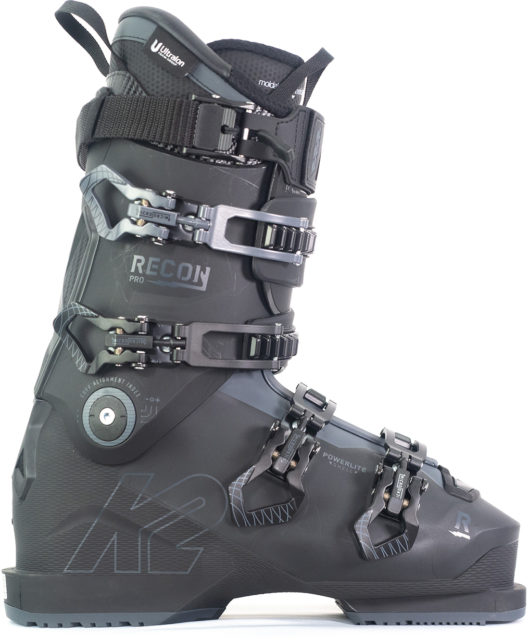
Intro
For the 2020-2021 season, K2 is adding the 140-flex Recon Pro (and 120-flex Women’s Anthem Pro) to their existing line of Recon boots. The standout characteristic of the Recon series is that they are very lightweight. In fact, the Recon boots are some of the lightest alpine boots on the market.
And so K2 subsequently adding the stiffer Recon Pro to this series leaves me with a few questions, most notable of which is whether the skiers who want the performance and support of a 140-flex resort boot will also appreciate its relatively low weight? And can you really get a true 140 flex out of a boot this light?
We’re planning on posting our full review next season once we can spend more time in it, but in the meantime, we’re taking a closer look at this unique boot:
Weight
At an average measured weight of 1761 grams per boot for a size 26.5, the Recon Pro does add a little over 100 grams per boot compared to Recon 130. While notable, my guess is that the weight difference will only be subtly noticeable while skiing, if noticeable at all. And despite the added weight, the Recon Pro is still a very light alpine boot and much, much lighter than other boots in the 140-flex class (most of which are race-oriented boots that are extremely heavy).
Again, this leaves me wondering how supportive the Recon Pro will feel (especially in terms of rearward and torsional flex), particularly for those people seeking a 140-flex boot. While the cuff is Pebax and the “spine” on the back of the cuff is carbon — materials more frequently used in lighter touring boots — the clog is still the ubiquitous PU material of many alpine ski boots. That said, I’m interested to see how the thinned walls of the PU shell react when skiing since they’re way thinner than every other 140-flex boot I’ve seen.
Weight Comparisons
For reference, below are a number of our measured weights for some other notable boots (keep in mind the size differences). Our measured weights show the size of boot, then the weight of each boot + the weight of each liner, then the total weight for shells + liners, listed in grams:
Head Nexo LYT 130 (26.5): 1082 & 1089 + 427 & 436 = 1509 & 1525 g
K2 Recon 130 LV (26.5): 1276 & 1277 + 369 & 374 = 1645 & 1651 g
Atomic Hawx Ultra 130 (26.5): 1270 & 1267 + 425 & 426 = 1695 & 1693 g
Salomon S/Pro 130 (26.5): 1367 & 1368 + 361 & 360 = 1728 & 1728 g
Salomon S/Max 130 Carbon (26.5): 1291 & 1292 + 445 & 446 = 1736 & 1738 g
K2 Recon Pro (26.5): 1334 & 1328 + 426 & 434 = 1760 & 1762 g
K2 Mindbender 130 (26.5): 1428 & 1427 + 346 & 348 = 1774 & 1775 g
Salomon S/Max 130 (26.5): 1389 & 1407 + 433 & 429 = 1822 & 1836 g
Nordica Promachine 130 (26.5): 1428 & 1428 + 444 & 445 = 1890 & 1891 g
Tecnica Mach1 130 LV (26.5): 1492 & 1494 + 472 & 472 = 1964 & 1966 g
Lange RX 130 LV (27.5): ~1702 + ~470 (avg weights) = 2172 g
Head Raptor 140 RS (26.5): 1892 & 1899 + 547 & 548 = 2439 & 2447 g
Shell
Overall, the Recon Pro’s shell isn’t super out of the ordinary, but there are some unique features. Its cuff is Pebax, the lower is PU, and the whole shell is reportedly heat moldable. It also features 2° of cuff adjustement (in both directions) via the pivot point at the ankle. The feature of the Recon Pro that really stands out as being unique is their “Power Plate,” which is an extra, removable layer of plastic sandwiched between the inner and outer cuff overlays. According to K2, simply having the plate in adds 5 stiffness points to the flex rating. With the pre-drilled holes in the cuff, the user has the option of adjusting the plate up or down 20 millimeters, and laterally roughly 10 millimeters. The higher the plate is set, “the more responsive the boot will be … you’ll feel like you’re engaging into the initial flex of the boot sooner,” says K2. And the lateral movability allows for people with varying calf sizes to dial in the fit of the cuff.
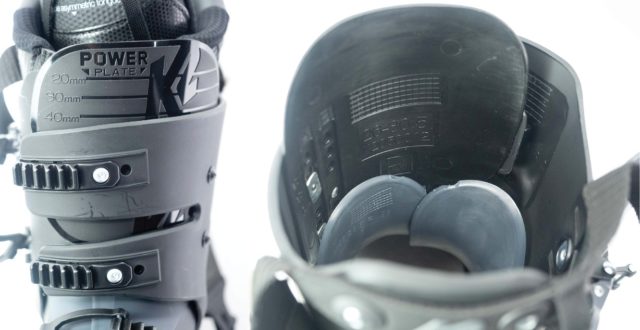
It’s also worth noting that the Recon Pro & Anthem Pro will only be available in a 98 mm last, whereas many of the other Recon & Anthem boots are available in both “LV” (98 mm) and “MV” (100 mm) versions.
Liner
While the Recon Pro’s shell is very lightweight compared to boots with similarly stiff flex ratings, its liner is not some super light, flimsy piece of foam.
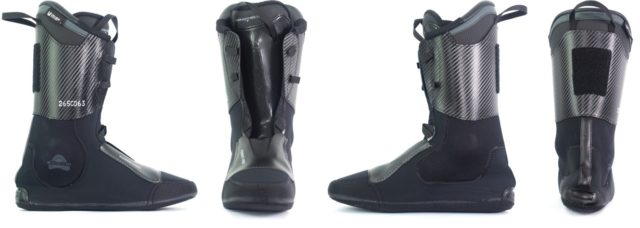
It reportedly uses the same “Powerfit Pro” liner as the Recon 130, which features a very dense, stiff foam around the ankle and heel, a softer foam through the foot, plastic reinforcements around the cuff, eyelets for laces, and a very stiff, heat-moldable plastic piece along the tongue. The whole liner is reportedly heat moldable.
Buckles & Power Strap
The Recon Pro features four low-profile, micro-adjustable buckles with flanges that make opening the buckles while wearing gloves or mittens easier, a thick, 45mm-wide, and slightly elastic power strap secured with a camming device. The power strap also features what K2 calls their “Ripcord” design, which is basically a pull tab that makes it easier to loosen the strap (the same camming device is used on the new K2 Mindbender AT boots).
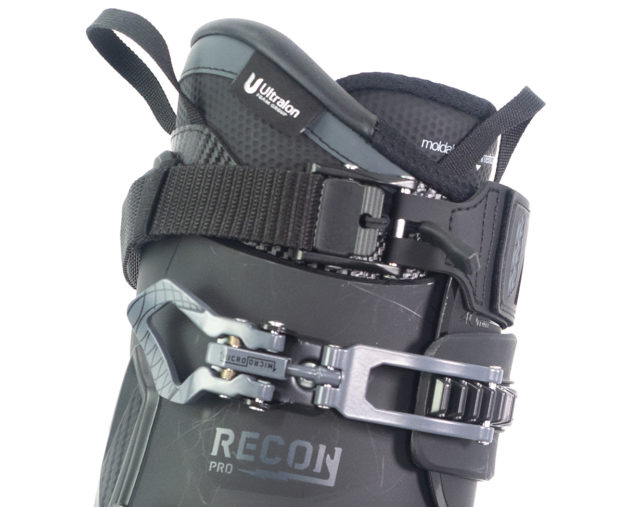
Soles & Binding Compatibility
While the other Recon & women’s Anthem boots come standard with GripWalk soles, the Recon Pro & Anthem Pro come with standard alpine soles that are replaceable and will work in any alpine binding.
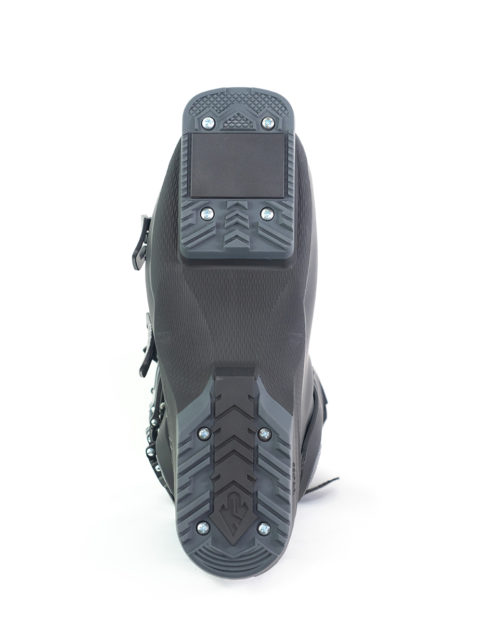
Fit
First and foremost — please go to a bootfitter to see what boot will work best for you. Fit is the most important thing with ski boots, and is where you’ll want to start. With that said, here’s how the Recon Pro fits my feet.
I grew up racing in plug boots and have continued to use race boots for many years, so I prefer a very tight fit. Common foot issues I have include high insteps (from calcified “surfer’s knots”), large aggravated ankle bones, bulbous accessory naviculars, and skinny heels with awkward bone spurs on the backs and sides. Despite all those grotesque trophies from a lifetime of skiing, my feet, ankles, and lower legs are fairly narrow, low-volume, and skinny.
Given all that, I’m accustomed to needing to do, and doing myself — I’m a bootfitter at the Alpineer in Crested Butte — a significant amount of boot fitting work for a size 26.5 boot before I can even ski them. But my reaction when first slipping on the Recon Pro was “wow, I could almost ski this right now.” The toe box, while still very snug, felt slightly wider and taller than the usual 98mm-last Nordica Dobermann GP 130 I’ve skied for the past few years. While I did feel significant pressure on my insteps in the Recon Pro, the heel pocket felt fantastically tight — exactly what I look for in a fit right out of the box.
Given all this, my lingering questions were (1) how much could the heat-molding process of the shell alleviate the unskiable-ness of my awkwardly formed (thanks to years of tiny race boots) feet, and (2) how aggressive of a shell mold should I do?
Heat-Molding Process
Like the other boots in the Recon series, the Recon Pro’s shell and liner is heat moldable, which is rare for a 140-flex boot. Most boots in the 140-flex range require grinding to the plastic because punches don’t hold as well over time due to the thick and highly elastic PU and PE of those stiffer alpine boots. Punching plastic can be time consuming and imprecise, so the prospect of getting a boot to fit after 15 minutes of work got me very excited. What I was wary of, however, was overdoing it. I still wanted a very tightly fitting ski boot.
I followed all of K2’s recommendations but decided to add less foam to my usual problem spots and shorten the cooking time by about 20% to avoid potentially making the boots too roomy. I figured I could attempt a second, more aggressive mold if necessary, but that I also had to account for the liner packing out from skiing. The result of the heat molding process was very impressive — so much so that I worry I may have gone overboard despite my caution. The boot felt almost a whole mondo size bigger. That worry will remain speculation until I can spend more time in the boot, but it’s worth noting for people who may be scared off by the stated 98 mm last of the Recon Pro.
Bottom Line
While we’ve seen a notable increase in the number of lightweight alpine boots over the past few years, that category hadn’t really extended into the 140-flex realm until the introduction of the K2 Recon Pro. Many of the recent, lightweight alpine boots are quite good for how light they are, so I will be curious to see whether that progression translates to the K2 Recon Pro, a boot with a flex rating suited for the most aggressive of inbounds skiers.

I skied the Recon Pro for a couple of weeks this winter. The shop did hundreds of dollars of additional work on them to get them as perfect a fit as possible. They felt so comfortable and I was pleased with their performance. The major problem I encountered, which lead me to returning them is that the Shell is too light weight and thin. I’m a heavy 260 lbs, and I folded that boot like it was a soft hiking boot whenever I flexed it. The shop kept telling me to change my technique, but after more than 30 years of skiing, that’s easier said than done. The consequence of the boot collapsing on my foot was that, my right foot in particular, would go totally numb after one run, and stay that way until I took a break. I gave up after 10 days of skiing the K2 and went to an off the shelf, but built with stronger materials, Lange RX 130, which I still need to have work done on, but Covid interrupted breaking that boot in after one night skiing at Brighton. I can still recommend the Recon Pro, but not for heavy people, or I would say heavier people who ski powerfully as the “140 flex” is like a 90 flex in a more traditionally built ski boot.
What do you do for your heel spurs? I find my heel spurs on the back of the heels are the hardest to accommodate when getting boots fitted. Boots with a smooth heel, like Langes, I’ve had good luck getting a punch in the heel area. But more and more boots have spines now, which makes punching in the heels impossible. And the thinner wall thicknesses of modern boots preclude grinding out a pocket.
Hey Shawn,
As you’ve indicated, it depends on the boot. Also, everyone’s heel spurs are a little different, and it sounds like yours might be higher than mine. I grind pretty much any alpine boot, even a boot like the thin-walled Recon Pro. I tend not to punch the heel pocket very often because It’s such an important part of the boot that I want to keep as precise a fit as possible, and punching can be somewhat imprecise.
So, I might cut out a piece of liner back there or aggressively heat press it. Or I might adjust the varus on my insoles outward a bit–sometimes heel spurs are a symptom of pronation causing your feet to collapse inward on the arch which, in turn, causes the outside/upper part of the heel to be exposed to more rubbing on the heel pocket of the shell.
What also has worked for me is…ensuring the boot conforms to your foot pretty naturally out of the box (I know not all people can try on multiple pairs of boots in a shop if they’ve found them cheaper online). But a really tight heel pocket that allows for no movement in the heel at all often relieves my heel spur issues. It’s movement that ultimately causes those bumps to enlarge and become aggravated. And I’ve personally found that an overall tighter fitting boot helps with this.
Tight fit=better performance, therefore easier skiing. And it sounds like you’re not shy with having your shop put a lot of time into making your boots fit, so perhaps downsizing the boot and putting that extra time into grinding and stretching the other problem spots will help your heels.
Those are just my thoughts, not rules by any means, or even things that will work for everyone.
BTW, what mondo size does your foot measure, and what boot size are you in?
Measure a 27.5, and boot size is a 27.5. A couple bootfitters a while back took great pride in seeing how small a boot they could cram my feet into. Just made for a whole season of painful and frustrating skiing, so downsizing to a 26.5 is out of the question. Current resort boots are Salomon XMax from 3 or 4 years ago with zipfits, and the heels are ground out thoroughly to smooth out all the ridges and plastic joints on the inside. Use 27.5 MTN Labs with Intuition Tour Wraps for touring. Interestingly enough, the heels work for me with just the standard oven bake and heat mold even though the whole ankle and heel area of the MTN Labs feel cavernous compared to the XMax.
Have been worryingly seeing the trend toward thinner and thinner wall thicknesses. Also spines, buttresses, and all sorts of appendages on modern boots, so kind of dreading the day I need to replace my XMax’s and wondering how modern boots could be made to fit my heels.
Drew,
I’m happy to have had this boot since mid-January 2020. I have had about 15 days on the boot before CoVID and came off of the Recon 130 LV and before that a BD foam liner in a Nordica GP 130 too. I am a former high level racer and I appreciate a light boot after more than 50 years of skiing everything from rubberized leather lace ups to 30 years in full WC boots and liners. This boot is a dream!!! Straight out of the box it is skiable and I disagree with heat moulding before it has been skied on for at least three hours. The bite over the instep is a common issue with the K2 Recon line but an easy correction for a good boot fitter. This boot finally fills the bill for a stiff light powerful boot with a roomy toe box. The closest thing the general public needs in a stiff performance boot without having to use a plug boot or near plug boot.
My first run was on hard as rock corduroy with a GS ski. I was able to drive the ski better and stronger than my Recon 130 that I stiffened with some strategic use of carbon. With the stiffener all the way up the boot is powerful and strong enough to even drive SG skis well. This boot just made me smile to know I have a boot that fits off the shelf without the need to have a custom foam liner made for it. This a success story for old guys like me to not have to have all of the weight on my feet but still get a boot that is strong enough to drive the stiffest of skis well. My only hesitation is that the energy transfer is too much and too strong for the boot to be used on a soft wide (100mm+) tip/tail rocker ski. But that’s not the market I think K2 was going after on this one. Please let this CoVID end so we can dig trenches on the piste again.
I’m looking to replace a pair of Atomic Waymaker Carbon 130s with something just as stiff, just as wide, and hopefully a lot lighter. 80% of my skiing is lift-accessed, and most of the touring is resort accessed side country, not all day trips so I think the superlight boots are overkill for me… Is this something I should be looking into? Or what other boots maybe in my wheelhouse?
We haven’t had any reviewers use the Waymaker Carbon 130, but I did just talk to Atomic’s head of ski boots about your question and here’s what he said:
“He should definitely look at the Hawx Prime XTD 130. The Waymaker series of boots used a Prime-ish 100mm last that had a Live Fit zone on the outside portion of the foot that would automatically expand with foot pressure. Because of that, it felt wider than a normal Prime right out of the box, but with how moldable our shells our now, he should have no trouble getting a Prime XTD 130 to work. It will be stiffer, lighter and tour way better than his Waymaker.”
I’ve used the Prime XTD 130 and I think it’s a very good boot, particularly for people who spend a good portion of their time touring, though it could also work for what you need if you want something very lightweight and that walks really well. It also might be worth trying on some slightly heavier options like the Nordica Strider 130 or Lange XT3 MV 130, which feel a bit more “plush” and comfortable when skiing hard on firm, rough snow (we like to say they feel like they have better “suspension” than lighter boots). And if you don’t need a boot with a walk mechanism, the regular Hawx Prime 130 might make more sense than the XTD, given that the regular Prime is still quite lightweight but uses a slightly heavier PU shell that I think would provide better suspension / a smoother ride on rough conditions.
I BROKE MY LEFT LOWER SHELL ON MY K2 RECON PRO 140 190lbs
What did y’all end up thinking of these long-term? Curious to hear your thoughts on these and possibly the Recon Team, as I’m considering the Recon 140 BOA